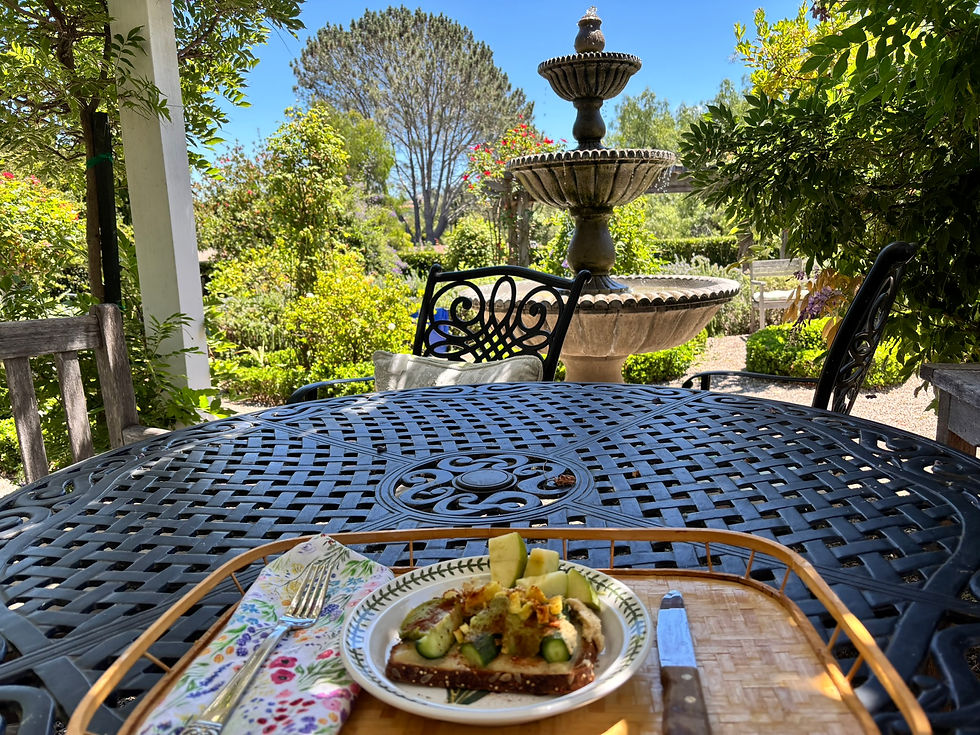GARDEN SURROUNDINGS: Nighttime Temperatures Determine When Flowers Bloom
- k-england
- Jul 31
- 4 min read
Updated: Aug 4
By Francesca Filanc, for Let’s Talk Plants! August 2025.

Mama noticed a week and a half ago that there were absolutely no blooms on her Pink Melaleuca, Melaleuca nesophila, a plant that is pruned in a beautiful way at the bottom of her garden and then, the very next day, the plants were just covered with blooms in a carpet of stunning color. (Pat Welsh is an author and TV personality and you can buy her books used online Southern California gardening a month-by-month Guide completely revised and updated).
Climate change wreaks havoc with flowering plants, trees and fruit. The following information comes from a statement primarily about tomatoes but has applications to all plants...
Heat consistently above 90 degrees F and nights above 70 degrees F will greatly reduce a plant's ability to flower and pollinate. There is a critical time when the first tomato flowers appear that they open and pollinate with the stigma. But if they cannot open and pollinate, they will drop their flowers unpollinated... Most flowering plants prefer the same daytime temperature range but grow best when nighttime temperatures range from 55 degrees to 60 degrees F. Lower nighttime temperatures help the plant: recover from moisture loss, intensify flower color and prolong flower life.
On a positive note, in our Mediterranean climate many plants bloom year-round, which gives birds, butterflies, and dragonflies a sanctuary to nest and live in our gardens. This garden that was created over the last seven years is a haven for wildlife and a sanctuary for humans as well.

Just before I started writing this article, I was communing with nature in the garden while enjoying my lunch and it gave me such peace and joy. Now, while I write this article, I can hear dozens of birds flitting to and fro across the garden. Also, blessed to have grandchildren and one daughter here on and off during the month of July, and everyone, including friends that came, enjoyed the garden.
When I moved to this property ten years ago, in the middle of August 2015, I knew that I wanted to take out the lawn in front and to make it into the garden that it is today. It is remarkable to me that it is thriving as if it’s been here much longer than its short seven years. The garden changes constantly, both with the seasons and as the plants mature, and I encourage any of you that want to do something like this on your property, especially with climate change, to go for it! It’s so important to have our own sanctuary if possible. Gardens give so much pleasure; for animals there is food, sustenance, shelter..., as well as, for the humans who work in and those that are visitors to a garden, there is beauty, joy, and peace.

Nine years ago, a pergola was built along the walkway from the street to the front door for the purpose of planting six Chinese Cooke’s variety wisteria at each post. Wisteria is drought resistant when established and the instructions for how to plant them can be found on my blog at my website francescafilanc.com. Luckily, I had it built away from the front door so it’s far enough away for fire safety.

I have many books illustrating beautiful gardens from around the world, and I put about fourteen of those books on my dining room table and poured through them marking the pages of what I love in a garden and what turns me on. That’s how I started this project. My handyman took over a year using concrete building blocks to make three terraces. I also asked him to build me another pergola down to another street and I designed for it a wrought iron gate.
Color palette is important to the garden. I knew I wanted to plant Lady Banks because it’s the only thornless rose and I wanted it to bloom at the same time as Petrea volubilis, a blue purple plant native to Australia. After all the garden terraces were built, I took a two and half-month trip around the world visiting six countries; New Zealand, Australia, Japan, Dubai, and Spain to visit my children and grandchildren, and England visiting relatives and gorgeous gardens.
The front garden is surrounded by two streets. From the beginning I knew I wanted privacy from the streets and Texas privet, Ligustrum japonicum 'Texanum', was the perfect solution to plant along the outskirts of the garden to give privacy from the roads.

Paths were designed to go through the garden. Wandering paths through a garden make fun spots for little children to run through giggling and playing hide and seek and fun for adults. My grandchildren were all small then and they have grown up with this garden. Currently some of them live in Northern California and some of them live in Spain, but every time they come to visit now there’s something different in bloom that they remember enjoying through their early childhood. My granddaughters in Spain will text me on WhatsApp.
“Mimi, there’s a Wisteria blooming and it reminds me of you and your garden.”
What could give more joy than that to a grandmother?
As I close this article, I’m off to pick up mama to come over for a visit in the garden, and then we will go to dinner.

Enjoy creating a sanctuary for yourself and birds and butterflies.
Happy Gardening!
~Francesca
In addition to painting fine art Francesca Filanc – Francesca's Fine-Art and writing for the San Diego Horticultural Society's newsletter, Let's Talk Plants! https://www.sdhortnews.org/post/garden-surroundings-borage-all-things-summer-mom-and-apple-pie, Francesca has started a YouTube channel called Living the Life You Envision with Fran - be sure to check it out! http://www.youtube.com/@LivingtheLifeYouEnvisionwi-u1w

Artist, author, photographer, fly-fisher woman, Francesca Filanc grew up in old Del Mar and these days lives, paints and gardens in historic Olivenhain with her two dogs.
Find her art and writings here:
She can be found on social media:
"Live The Life You Envision with Fran" YouTube Channel:
Have gardening questions or want to learn more about Francie’s art?
Contact: Franfilanc@gmail.com









